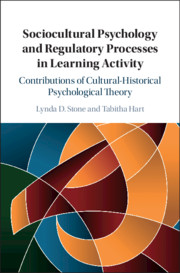 Sociocultural Psychology and Regulatory Processes in Learning Activity
Sociocultural Psychology and Regulatory Processes in Learning Activity Book contents
- Sociocultural Psychology and Regulatory Processes in Learning Activity
- Sociocultural Psychology and Regulatory Processes in Learning Activity
- Copyright page
- Dedication
- Contents
- Figures
- Transcription Excerpts
- Foreword
- Acknowledgments
- Transcription Conventions
- Introduction
- Chapter 1 Cultural-Historical Psychological Theory
- Chapter 2 The Relational Habitus and Regulatory Processes
- Chapter 3 Practical-Moral Knowledge and Regulatory Processes
- Chapter 4 Identity and Competence Woven Together Through Regulatory Processes
- Chapter 5 Contextual Mood and Regulatory Processes
- Conclusion
- References
- Index
Chapter 4 - Identity and Competence Woven Together Through Regulatory Processes
Published online by Cambridge University Press: 30 September 2019
- Sociocultural Psychology and Regulatory Processes in Learning Activity
- Sociocultural Psychology and Regulatory Processes in Learning Activity
- Copyright page
- Dedication
- Contents
- Figures
- Transcription Excerpts
- Foreword
- Acknowledgments
- Transcription Conventions
- Introduction
- Chapter 1 Cultural-Historical Psychological Theory
- Chapter 2 The Relational Habitus and Regulatory Processes
- Chapter 3 Practical-Moral Knowledge and Regulatory Processes
- Chapter 4 Identity and Competence Woven Together Through Regulatory Processes
- Chapter 5 Contextual Mood and Regulatory Processes
- Conclusion
- References
- Index
Summary
In Chapter 4, we suggest that competency be reimagined as a social identity. Social identities are inhabited or embodied representations (signs) of the values and statuses (possible roles) of a community. Social identities can be explicit or implicit. An identity of competency is an example of an implicit form of social identity that is linked to a local community’s socially shared but tacit category for competency. This category represents the values and expectations for how to be, act, or feel like a competent member of a community. In learning settings, an identity of competency is implicitly valued and highly desired because it brings recognition and status (rights/power) for regulating the behaviors of self and others as well as indicates a willingness to persist in complex learning. Understanding how this form of identity is enacted can reveal what forms of behavior regulation indicate competency in learning communities.
Keywords
- Type
- Chapter
- Information
- Sociocultural Psychology and Regulatory Processes in Learning ActivityContributions of Cultural-Historical Psychological Theory, pp. 70 - 86Publisher: Cambridge University PressPrint publication year: 2019


